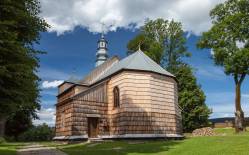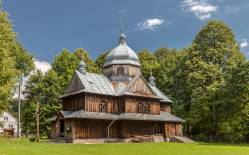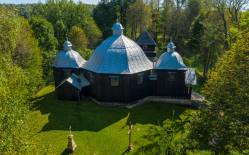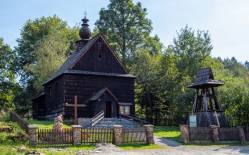In the last village on the way towards the Polish-Ukrainian border you can see an old Greek-Catholic tserkva standing on a hill overlooking the Strwiąż River valley; today it is a Roman-Catholic church.
A reference to the first church here dates from 1558. The tserkva of Nativity of the Mother of God was built in 1794−1799. After 1951, when the village population was forcefully resettled, the building was abandoned. Later it was used as a sheepfold or a fertiliser storage by a farming cooperative run by Greek people living here at the time. They were relocated to Krościenko after 1948, when they had to flee their country in the aftermath of the civil war. Most of them returned to Greece after the 1968 amnesty, only a few Greek families remained in Krościenko area. In 1971 the devastated tserkva was taken over by Roman Catholics who thoroughly restored it in 1973. From that time, the building has been used as the parish church of Nativity of the Blessed Virgin Mary.
The three-part log church, oriented eastward, is covered with wood boards. On the northern side, the chancel is adjoined by a sacristy. A small post-and-beam porch leads to the narthex. The gable roofs are clad with shingles. Over the nave there is a dome supported on an octagonal drum, also covered with shingles. Over the chancel and the narthex, we can see small turrets with onion-shaped cupolas. Inside there are beam ceilings, the one in the nave fastened by two crossing bearers.
Majority of the interior furnishings have not been preserved, while some artefacts, such as fragments of the iconostases from the 1600s and 1800s, a procession float from the 19th century and a stone baptismal font are in the holdings of the Castle Museum in Łańcut. The 19th century crucifix was brought here from Humniska.
Nearby we can see a post-and-frame belfry from the 1800s; it is covered with a shingled pyramid roof. There is also a cemetery with a few old tombstones.
Photo: Krystian Kłysewicz
Gallery
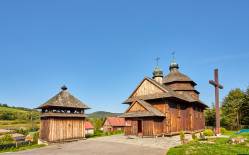
Recommended venues on the Trail



This website has been modernized with the financial support of the European Union under the Cross-Border Cooperation Programme Poland-Belarus-Ukraine 2014-2020. The responsibility for its content lies solely with the Podkarpackie Regional Tourism Board and cannot, in any case, be treated as a reflection of the position of the European Union, the Managing Authority, or the Joint Technical Secretariat of the Cross-Border Cooperation Programme Poland-Belarus-Ukraine 2014-2020.










